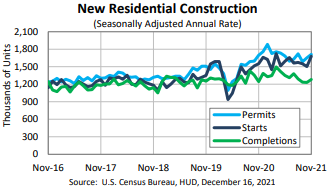 The pace of new-home construction jumped in November, as builders hustled to meet surging demand against a backdrop of short supply.
The pace of new-home construction jumped in November, as builders hustled to meet surging demand against a backdrop of short supply.
Single-family housing starts jumped 11.3% from October’s revised estimate to 1,173,000, and multifamily starts surged 12.1% to 491,000, according to the U.S. Census Bureau and the U.S. Department of Housing and Urban Development.
Altogether, the combined construction pace of single-family homes and buildings with five or more units was up 11.8% month over month, at 1,679,000 units. Starts were up 8.3% compared to a year ago.
Year over year, single-family starts were down 0.8%, and multifamily starts were up 39.1%.
“November’s housing starts report signals strength for the housing market,” First American deputy chief economist Odeta Kushi said in a press release, noting that housing completions rose 4%. “The growth in completions means more homes on the market in the short-term, offering some immediate relief in alleviating housing supply shortages.”
The seasonally adjusted annual rate for privately owned housing units authorized by building permits was at 1,712,000 in November, up 3.6% from October’s revised rate and up 0.9% compared to November 2020.
 Privately owned housing completions hit an annual rate of 1,282,000 in November, up 4.1% from October and 3.1% from a year earlier.
Privately owned housing completions hit an annual rate of 1,282,000 in November, up 4.1% from October and 3.1% from a year earlier.
By region, single-family new-construction activity was higher across the U.S. It jumped 26.9% in the Northeast to 66,000, 14.4% in the South to 701,000, while it rose 5.7% in the West to 277,000 and 1.6% in the Midwest to 129,000.
The strong pace of new-home sales in September and October indicates market optimism and suggests that as supply-chain issues are worked out, the pace of housing starts will rise, RCLCO Real Estate Consulting principal Kelly Mangold said.
Mangold also noted that millennials comprise the greatest share of home-loan applicants, and the current work-from-home environment in which they are entering their family-formation years suggests increased demand for growing-family and home-office space.
“The bottom line is we need more homes, and it will take time to reduce the housing stock ‘debt’ in the face of growing demand,” Kushi said and pointed to the recently released report from the National Association of Home Builders, which showed the fourth consecutive increase in builder confidence. “Today’s housing starts report, in combination with a positive builder’s sentiment report, sends an optimistic message about the housing market as we enter 2022.”
